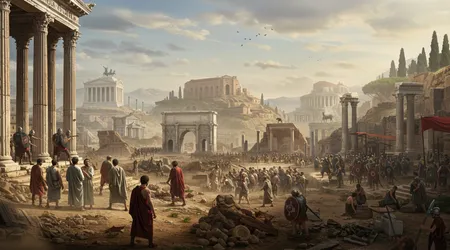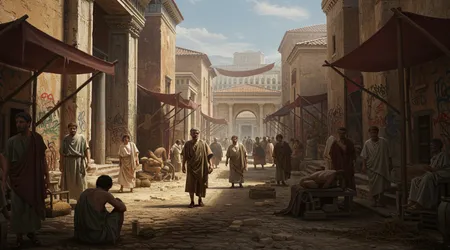The Real Reason the Roman Empire Fell

The reason the Roman Empire fell captivates historians, scholars, and curious minds alike, sparking debates that echo through centuries.
Anúncios
Was it a singular cataclysmic event, a slow-burning decay, or a tapestry of interwoven failures?
The fall of Rome, traditionally marked in 476 CE when the last Western emperor, Romulus Augustulus, was deposed, wasn’t a sudden curtain drop but a gradual unraveling of a once-mighty civilization.
This exploration dives into the hidden and forgotten threads of history, peeling back layers of economic strain, social fragmentation, environmental pressures, and political missteps.
By examining these factors with a fresh lens, we uncover a narrative that challenges simplistic explanations, offering a nuanced view of an empire’s twilight. Why did Rome, a beacon of power, crumble? Let’s journey through the shadows of history to find out.
Anúncios
This article, crafted for the Hidden and Forgotten History blog, aims to illuminate lesser-known aspects of Rome’s decline while grounding the discussion in verifiable truths.
We’ll weave together historical evidence, modern scholarship, and engaging storytelling to reveal the complexities behind the reason the Roman Empire fell.
From the erosion of civic virtue to the whispers of climate change, prepare to see Rome’s collapse in a new light, with insights that resonate even in 2025.
Economic Erosion: The Silent Killer
Rome’s economy, once a robust engine, faltered under its own weight. Overexpansion stretched resources thin, with vast territories demanding constant military funding.
The empire’s reliance on conquest for wealth dried up as victories slowed. By the 3rd century, inflation soared; the denarius, Rome’s silver coin, lost value rapidly. A 2019 study by historian Kyle Harper notes that by 250 CE, the currency’s silver content plummeted by 80%, crippling trade.
Taxation became a crushing burden. To fund endless wars, emperors hiked taxes, squeezing the middle and lower classes. Small farmers, unable to pay, abandoned lands, shrinking agricultural output.
++ Lost Languages and the Race to Decode Them
This cycle of economic strain weakened the empire’s foundation, making it vulnerable to external shocks. The reason the Roman Empire fell lies partly in this fiscal mismanagement, a slow bleed few noticed until too late.
Wealth inequality exacerbated tensions. Elites hoarded resources, while urban poor swelled, fueling unrest. Rome’s bread-and-circus policies free grain and spectacles kept crowds pacified but drained treasuries.
By the 4th century, economic stagnation set in, with trade routes disrupted by barbarian incursions. The empire’s inability to adapt economically was a quiet but deadly force in its decline.

Social Fragmentation: A House Divided
Rome’s social fabric frayed as unity dissolved. The empire’s vast diversity, once a strength, became a liability as cultural cohesion weakened. Roman citizens, especially in distant provinces, felt little loyalty to a far-off emperor.
The reason the Roman Empire fell includes this growing disconnect, as local identities trumped imperial allegiance.
Class divisions deepened. The senatorial elite clung to privilege, while the plebs faced poverty and disenfranchisement.
Also read: The Hidden Role of Africa in Ancient Global Trade
Slavery, a cornerstone of Rome’s economy, stifled innovation, as cheap labor discouraged technological advances. A post on X highlights this, noting overreliance on slave labor as a key factor in Rome’s stagnation.
The rise of Christianity, often cited as a divisive force, shifted values. Edward Gibbon argued it eroded martial spirit, though modern scholars dispute this, noting Christian soldiers fought fiercely.
Still, religious schisms between pagans and Christians created social rifts. These internal fractures left Rome brittle, unable to withstand external pressures.
Environmental Pressures: Nature’s Unseen Role
Climate change, rarely discussed, played a subtle yet significant role. The Roman Warm Period (c. 100 BCE–200 CE) gave way to cooler, drier conditions, disrupting agriculture.
Tree-ring data from the 3rd century show “distinct drying,” reducing crop yields. This environmental shift strained food supplies, fueling famine and unrest.
Plagues also ravaged Rome. The Antonine Plague (165–180 CE) killed up to 10% of the population, weakening the workforce and military.
Later, the Plague of Cyprian (250–262 CE) further decimated cities. These crises, tied to the reason the Roman Empire fell, exposed Rome’s fragility to natural disasters.
Read more: The Forgotten Scientists Who Laid the Groundwork for Modern Physics
Urban overcrowding worsened disease spread. Poor sanitation, as noted in posts on X, compounded mortality rates, undermining economic stability.
Rome’s inability to adapt to environmental challenges unlike its aqueduct-building past revealed a civilization losing its edge. Nature, often overlooked, was a silent saboteur.
Political Instability: The Revolving Door of Emperors
Rome’s political system crumbled under incessant turmoil. The 3rd century saw the Crisis of the Third Century, with over 20 emperors in 50 years. Frequent assassinations and coups destabilized governance.
The reason the Roman Empire fell includes this chaotic leadership, as loyalty to emperors waned.
The Praetorian Guard, meant to protect, became kingmakers, auctioning the throne to the highest bidder. In 193 CE, they sold the empire to Didius Julianus, a stark example of corruption.
Centralized power under emperors like Commodus, described as “juvenile” and “decadent,” eroded trust.
Diocletian’s reforms in 284 CE, splitting the empire into East and West, aimed to stabilize but created new divisions. The Western Empire, poorer and less defensible, bore the brunt of invasions.
Political fragmentation, driven by ambition and betrayal, left Rome a shadow of its former self.
External Pressures: Barbarians at the Gates
Barbarian invasions are often overstated as the sole cause, but they exploited Rome’s weaknesses. The Visigoths’ sack of Rome in 410 CE shocked the world, signaling vulnerability.
By 476 CE, Odoacer’s coup ended the Western Empire. The reason the Roman Empire fell intertwines with these external shocks.
The Huns, led by Attila, pressured Germanic tribes, pushing them into Roman territory. This migration overwhelmed borders, as Rome’s legions, once invincible, were underfunded and overstretched.
Peter Heather argues Rome’s aggressive imperialism sowed its own destruction by provoking barbarian responses.
Yet, barbarians weren’t merely destroyers. Many integrated, serving in Roman armies. The failure to assimilate them effectively, however, fueled internal chaos.
The reason the Roman Empire fell wasn’t just invasion but Rome’s inability to manage its diverse frontier populations.
The Myth of a Single Cause: A Tapestry of Collapse

Blaming one factor oversimplifies Rome’s fall. Was it Christianity, as Gibbon suggested, or economic collapse? Perhaps political instability or environmental stress?
The reason the Roman Empire fell lies in their convergence, each amplifying the others’ impact.
Consider a modern analogy: a skyscraper collapsing not from one flaw but from weakened foundations, cracked supports, and an earthquake’s final push.
Rome’s decline mirrors this, with no single culprit. A 1984 study by Alexander Demandt lists 210 theories, from moral decay to lead poisoning, showing the complexity.
This multifaceted collapse offers lessons for today. Overreliance on finite resources, social division, and environmental neglect echo in modern societies.
The reason the Roman Empire fell isn’t just history it’s a warning. How can we avoid Rome’s fate in our interconnected world?
Table: Key Factors in Rome’s Decline
| Factor | Impact | Example |
|---|---|---|
| Economic Erosion | Inflation, heavy taxes, wealth disparity | Denarius devaluation by 80% (250 CE) |
| Social Fragmentation | Loss of unity, class divides, slavery | Rise of Christianity vs. paganism |
| Environmental Pressures | Climate shifts, plagues, poor sanitation | Antonine Plague killed 10% (165 CE) |
| Political Instability | Frequent emperor changes, corruption | Praetorian Guard’s 193 CE auction |
| External Pressures | Barbarian invasions, border strain | Visigoths’ sack of Rome (410 CE) |
Conclusion: Lessons from Rome’s Twilight
The reason the Roman Empire fell is no singular event but a symphony of failures, each note resonating with the others. Economic collapse drained vitality, social divisions eroded unity, environmental crises tested resilience, political chaos broke trust, and barbarian pressures exploited every crack.
Rome’s story, rich with hidden details, reminds us that empires, no matter how grand, are fragile when their foundations erode.
In 2025, as we face global challenges economic inequality, climate change, political polarization Rome’s fall feels eerily relevant.
This exploration, rooted in historical truth, invites reflection. Rome wasn’t built in a day, nor did it fall in one. Its decline, a slow burn of interconnected crises, challenges us to learn from forgotten history.
Can we heed these warnings to build a more resilient future? The echoes of Rome’s collapse urge us to act wisely, lest we repeat its mistakes.
FAQ: Common Questions About Rome’s Fall
Q: Was Christianity the main reason the Roman Empire fell?
A: No, Christianity was one factor among many. Gibbon’s theory that it weakened Rome’s martial spirit is debated, as Christian soldiers fought bravely. Economic and political issues were more significant.
Q: Did barbarians destroy Rome overnight?
A: Not at all. Invasions like the 410 CE sack by Visigoths were symptoms of deeper issues economic strain, political chaos, and weakened defenses building over centuries.
Q: How does Rome’s fall relate to today?
A: Rome’s decline mirrors modern challenges: inequality, environmental stress, and political instability. Studying it helps us address these issues proactively in 2025.
Q: Were environmental factors really significant?
A: Yes, climate shifts and plagues, like the Antonine Plague, disrupted agriculture and population, weakening Rome’s economy and military, as recent studies confirm.
